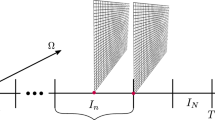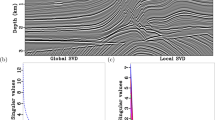Abstract
Currently the resolution of the head models used in electroencephalography (EEG) studies is limited by the speed of the forward solver. Here, we present a parallel finite difference technique that can reduce the solution time of the governing Poisson equation for a head model. Multiple processors are used to work on the problem simultaneously in order to speed up the solution and provide the memory for solving large problems. The original computational domain is divided into multiple rectangular partitions. Each partition is then assigned to a processor, which is responsible for all the computations and inter-processor communication associated with the nodes in that particular partition. Since the forward solution time is mainly spent on solving the associated matrix equation, it is desirable to find the optimum matrix solver. A detailed comparison of various iterative solvers was performed for both isotropic and anisotropic realistic head models constructed from MRI images. The conjugate gradient (CG) method preconditioned with an advanced geometric multigrid technique was found to provide the best overall performance. For an anisotropic model with 256 × 128 × 256 cells, this technique provides a speedup of 508 on 32 processors over the serial CG solution, with a speedup of 20.1 and 25.3 through multigrid preconditioning and parallelization, respectively.





Similar content being viewed by others
References
Ashby SF, Falgout RD (1996) A parallel multigrid preconditioned conjugate gradient algorithm for groundwater flow simulations. Nucl Sci Eng 124:145–159
Axelsson O (1995) Iterative solution methods. Cambridge University Press, New York
Carstensen C, Kuhn M, Langer U (1998) Fast parallel solvers for symmetric boundary element domain decomposition equations. Numer Math 79:321–347
De Sterck H, Yang UM, Heys JJ (2006) Reducing complexity in parallel algebraic multigrid preconditioners. SIAM J Matrix Anal Appl 27:1019–1039
Fan Y, Jiang T, Evans DJ (2001) Parallel algorithm for BEM based EEG/MEG. Neuroimage 13:S1301
Fuchs M, Wagner M, Kastner J (2001) Boundary element method volume conductor models for EEG source reconstruction. Clin Neurophysiol 112:1400–1407
Grama A, Karypis G, Kumar V, Gupta A (2003) Introduction to parallel computing. Addison–Wesley, Reading
Gropp W, Lusk E, Skjellum A (1994) Using MPI: portable parallel programming with the message-passing interface. MIT Press, Boston
Gullmar D, Haueisen J, Eiselt M, Giessler F, Flemming L, Anwander A, Knosche TR, Wolters CH, Dumpelmann M, Tuch DS, Reichenbach JR (2006) Influence of anisotropic conductivity on EEG source reconstruction: investigations in a rabbit model. IEEE Trans Biomed Eng 53:1841–1850
Hackbusch W (1994) Iterative solution of large sparse systems of equations. In: Applied mathematical sciences. Springer, New York, Vol. 95
Hallez H, Vanrumste B, Van Hese P, D’asseler Y, Lemahieu I, Van De Walle R (2005) A finite difference method with reciprocity used to incorporate anisotropy in electroencephalogram dipole source localization. Phys Med Biol 50:3787–3806
Hysom D, Pothen A (2001) A scalable parallel algorithm for incomplete factor preconditioning. SIAM J Sci Comput 22:2194–2215
Jing L, Zhu S, He B (2005) A finite difference method for solving the three-dimensional EEG forward problem. Proceedings of 27th Annual Int. Conf. IEEE EMBS, pp. 1540–1543
Laarne PH, Tenhunen-Eskelinen ML, Hyttinen JK, Eskola HJ (2000) Effect of EEG electrode density on dipole localization accuracy using two realistically shaped skull resistivity models. Brain Topogr 12:249–254
Lemieux L, McBride A, Hand JW (1996) Calculation of electrical potentials on the surface of a realistic head model by finite differences. Phys Med Biol 41:1079–1091
Malmivuo J, Plonsey R (1995) Bioelectromagnetism: principles and applications of bioelectric and biomagnetic fields. Oxford University Press, New York
Mohr M, Vanrumste B (2003) Comparing iterative solvers for linear systems associated with the finite difference discretization of the forward problem in electro-encephalographic source analysis. Med Biol Eng Comput 41:75–84
Neilson LA, Kovalyov M, Koles ZJ (2005) A computationally efficient method for accurately solving the EEG forward problem in a finely discretized head model. Clin Neurophysiol 116:2302–2314
Saleheen HI, Ng KT (1997) New finite difference formulations for general inhomogeneous anisotropic bioelectric problems. IEEE Trans Biomed Eng 44:800–809
Schimpf P, Haueisen J, Ramon C, Nowak H (1998) Realistic computer modeling of electric and magnetic fields of human head and torso. Parallel Comput 24:1433–1460
Vanrumste B, Van Hoey G, Van De Walle R, D’have M, Lemahieu I, Boon P (2000) Dipole location errors in electroencephalogram source analysis due to volume conductor model errors. Med Biol Eng Comput 38:528–534
Vanrumste B, Van Hoey G, Van De Walle R, D’have M, Lemahieu I, Boon P (2001) The validation of the finite difference method and reciprocity for solving the inverse problem in EEG dipole source analysis. Brain Topogr 14:83–92
Wolters CH, Kuhn M, Anwander A, Reitzinger S (2002) A parallel algebraic multigrid solver for finite element method based source localization in the human brain. Comput Vis Sci 5:165–177
Yang UM (2006) Parallel algebraic multigrid methods—high performance preconditioners. In: Bruaset AM, Tveito A (eds) Numerical solution of partial differential equations on parallel computers. Springer-Verlag, Berlin, pp. 209–236
Acknowledgments
This work was supported in part by the Los Alamos National Laboratory (LANL). The authors would like to especially thank Dr. Doug Ranken at the Biological and Quantum Physics Group, LANL for providing the segmented MRI image used to construct the head models.
Author information
Authors and Affiliations
Corresponding author
Appendix 1 Total solution time versus number of processors for tangential white matter fiber model
Appendix 1 Total solution time versus number of processors for tangential white matter fiber model
The total solution time versus the number of processors is given in Fig. 6 for the model with 256 × 128 × 256 cells and tangential fiber orientation in the white matter.
Total solution time for the anisotropic model with 256 × 128 × 256 cells and tangential white matter fiber. The methods shown are the CG (open circle), AMG (hyphenated line), GMG (asterisk), GMG-CG (open square), ILUBJ(0)-CG (open diamond), ILU(0)-CG (open triangle), and the JAC-CG (dots and dashes). The threshold (α) for AMG and the number of levels (l) for ILU are 0.3 and 0, respectively
Rights and permissions
About this article
Cite this article
Barnes, D.N., George, J.S. & Ng, K.T. Finite difference iterative solvers for electroencephalography: serial and parallel performance analysis. Med Biol Eng Comput 46, 901–910 (2008). https://doi.org/10.1007/s11517-008-0344-9
Received:
Accepted:
Published:
Issue Date:
DOI: https://doi.org/10.1007/s11517-008-0344-9





